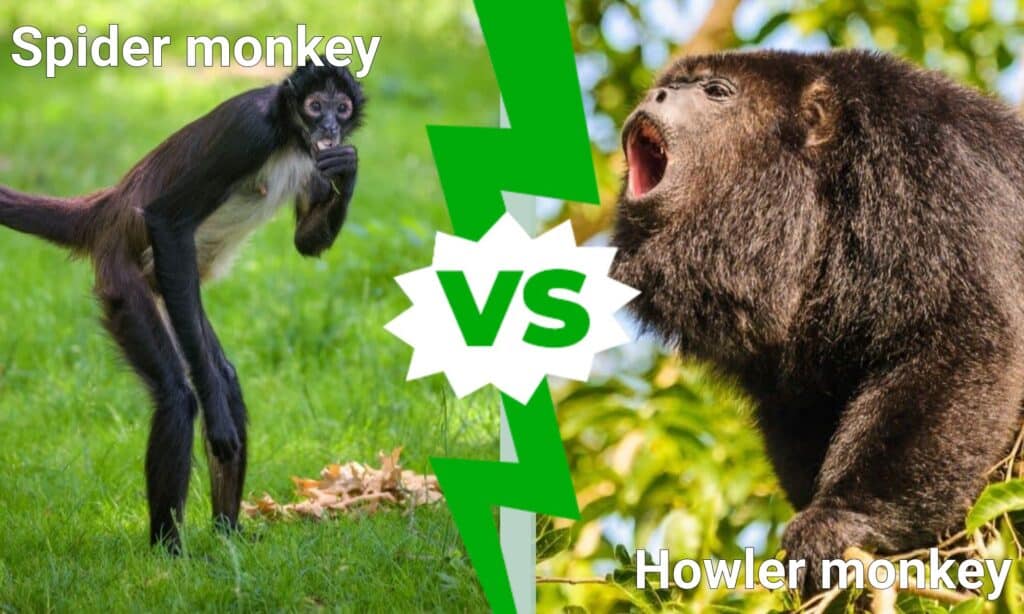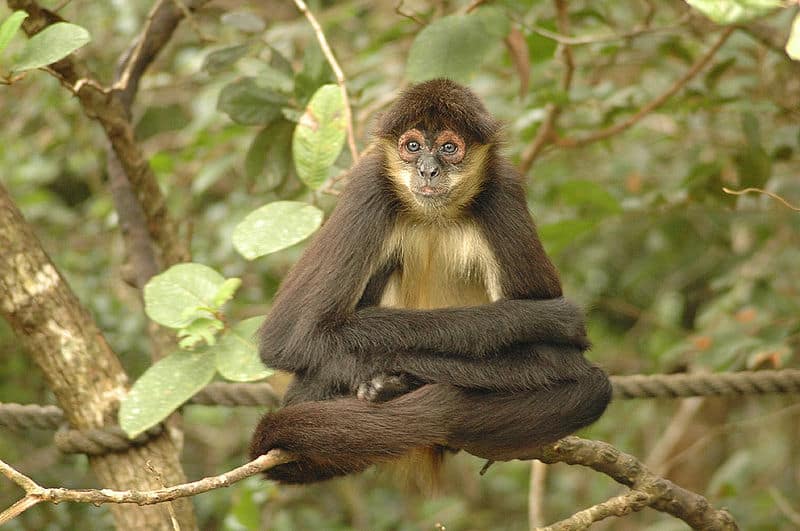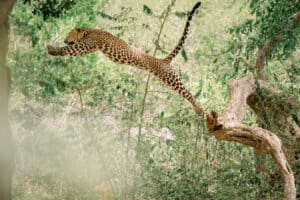New World monkeys are some of the most amazing creatures in the world, although the larger primates in Africa often get more attention. The spider and howler monkeys are prime examples of monkey species that have social groups and are extremely intelligent. Although there are some similarities between these two, some distinct differences set them apart. Today, we are going to learn what makes them unique. Let’s compare: Spider Monkey vs Howler Monkey.
Comparing a Spider Monkey and a Howler Monkey

| Spider monkey | Howler monkey | |
|---|---|---|
| Size | Weight: Up to 26 lbs | Weight: Up to 32 lbs |
| Appearance | Extremely long arms, legs, and tail. Colors depend on the species. | Stockier than spider monkeys. Inset eyes with rounded snouts. Often have drooping skin around head and neck. |
| Distribution | Southern Central America and Northern South America. | Southern Central America and as far south as Uraguay. |
| Vocalization | Barks similar to a dog, will occasionally growl. | Extremely loud vocalizations. Deep and guttural howls, giving them their name. |
| Intelligence | Among the smartest of all primates, likely the result of diet. | A brain size about half as large as a spider monkey. |
The 5 main differences between a Spider Monkey and a Howler Monkey
The main differences between spider monkeys and howler monkeys are their size, intelligence, and vocalization.
Both types of monkeys are classified as New World primates, meaning they are primates that live in the Americas. As with most New World monkeys, they have extremely long prehensile tails and are primarily arboreal (live in trees). Altogether, there are around 7 species of spider monkey and 15 species of howler monkey. Spider monkeys belong to the Ateles genus, while howler monkeys belong to the Alouatta genus.
Aside from their tails, there aren’t too many similarities between spider and howler monkeys, at least from their appearance. Spider monkeys have extremely long arms and look quite spindly when extended, giving them their name when they hang upside down. Howler monkeys are stockier and have rounded faces with large skin folds around their chin and cheeks.
Even if you can’t see either monkey, you can identify them through vocalization. Spider monkeys aren’t as loud and will bark or growl if threatened. As their name suggests, howler monkeys will howl to signal a threat. Howls are extremely loud, and they are often considered to be the loudest land animals in the world.
Let’s explore these differences in some more detail below.
Spider Monkey vs Howler Monkey: Size

Spider monkeys are a bit smaller on average than howler monkeys.
©Nick Fox/Shutterstock.com
Between the two, spider monkeys are a bit smaller. On average, they can grow up to 26 lbs, with males being slightly larger than females. Their tails can reach up to 35 inches long and are extremely strong and flexible.
Howler monkeys are slightly larger than spider monkeys, reaching around 32 lbs at a max. Although they aren’t as large as other primates in the world (gorillas and chimps), howler monkeys are among the largest New World primate species. Like the spider monkey, they have extremely long tails that can reach up to 30 inches.
Spider Monkey vs Howler Monkey: Appearance

Howler monkeys are usually stockier than spider monkeys.
There are a few species of spider monkey, all with variations in their exact appearance. Still, there are some things that most spider monkeys have in common. They get their name from their extremely long arms and legs that appear spindly. When they hang upside down, they look like spiders hanging from a web. They have large eye patches that are often black or brown.
Howler monkeys are stockier than the average spider monkey. They have shorter bodies and arms and usually appear thicker and heavier. Additionally, howler monkeys have large skin and hair folds around their heads and necks. This often results in a drooping sack around their chin and is quite characteristic of the species.
Spider Monkey vs Howler Monkey: Distribution

Spider and howler monkeys live in Central and South America.
©Nick Fox/Shutterstock.com
Both spider and howler monkeys are native to the New World, although spider monkeys have a slightly smaller distribution. They are generally found as far north as Mexico and as far south as northern Bolivia. They aren’t found further west than French Guiana.
Howler monkeys have a wider distribution, but only slightly. They can be found as far north as Mexico but with a southerly range as far as Uraguay.
Spider Monkey vs Howler Monkey: Vocalization

Howler monkeys sound can travel up to three miles of thick forest.
©Anton_Ivanov/Shutterstock.com
The spider monkey doesn’t have a notable vocalization, especially when compared to the howler. It will generally bark like a dog or growl if threatened.
Howler monkeys, on the other hand, get their name from their howl. They are occasionally recognized as one of the loudest land animals on earth. Check out a sound clip of a howler monkey below.
Spider Monkey vs Howler Monkey: Intelligence

Spider monkeys may be the most intelligent animals, aside from humans, in the New World.
©Ateles geoffroyi / CC BY 2.0 – License
All monkeys are quite intelligent but in varying degrees. Spider monkeys are among the most intelligent monkeys in all of the new world, with some studies even having them as the most intelligent, displacing the capuchin monkey for number one. The intelligence of a spider monkey likely comes from their diet of ripe fruit, requiring them to remember dozens of locations and when they ripen.
Howler monkeys have about half of the brain size of a spider monkey of equal mass. This doesn’t mean that howler monkeys are necessarily half as intelligent, but their memory and cognitive skills aren’t on par with a spider monkey.
The photo featured at the top of this post is © StanBullett/Shutterstock.com
Thank you for reading! Have some feedback for us? Contact the AZ Animals editorial team.







